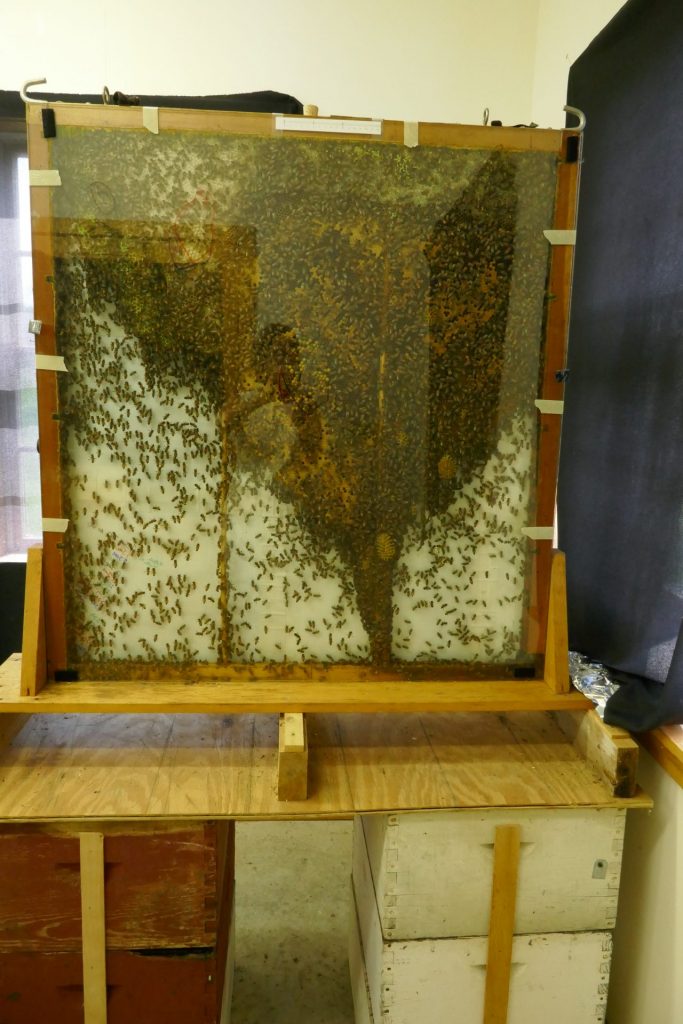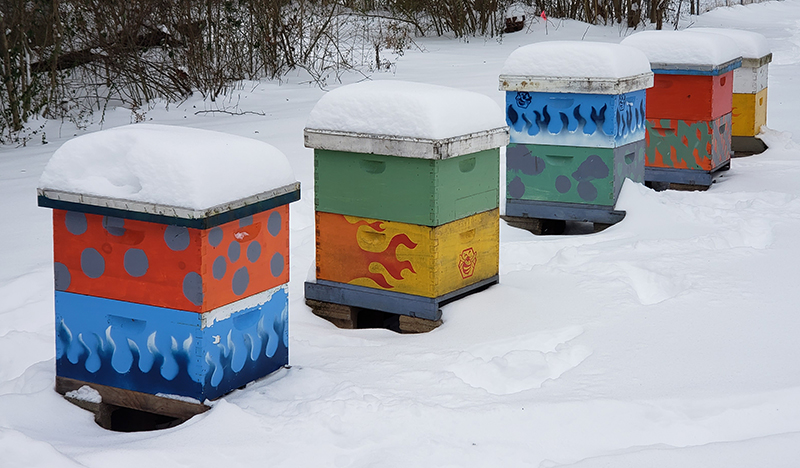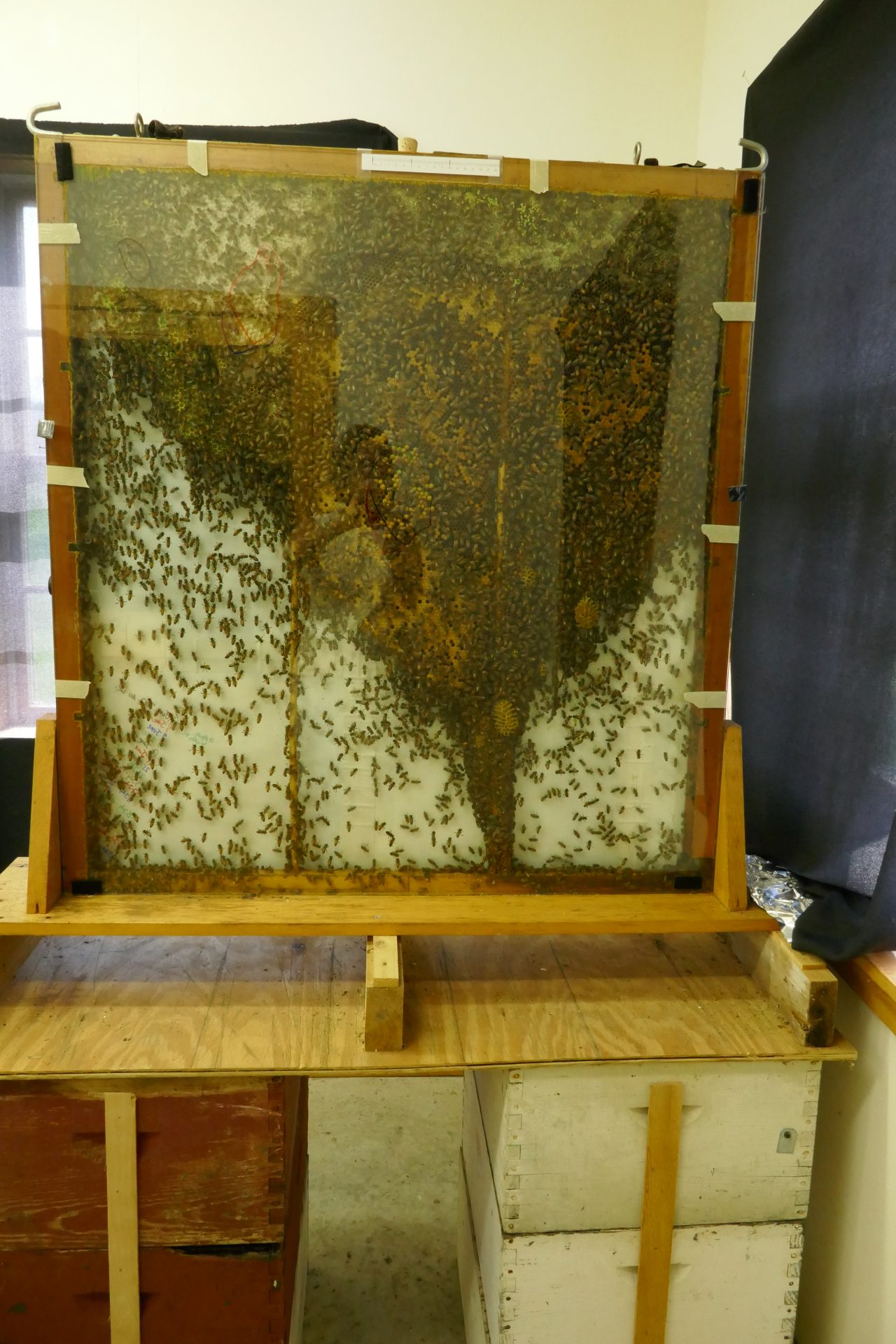
Introduction.
As a novice observation hive beekeeper, this is only my second attempt at overwintering a tiny colony, I’m trying to manage the wee colony in the best possible way without having to heat the shed. This colony started as a tiny secondary swarm this summer and is still collecting ivy pollen on fine days. It has not yet formed a winter cluster though the queen has stopped egg laying.
The winter of my first year was a cold one, and that wee colony had plenty stores but there was a lot of condensation building up on the floor on either side of the two frames and the combs got mouldy. The colony came through that winter but was small and the queen died. The following year I kept an observation hive only over the summer and moved the frames into a poly nucleus box for overwintering on a table just outside the entrance to the indoor hive. This year, I’m keeping them inside the shed, but with more confidence now I know that condensation is good and to be expected. I’ve also learned that keeping an observation hive indoors in a warm environment is not a good thing so I’m pleased that my original plan to set it up in the bedroom was rejected.
I’m very grateful to Tom Seeley, my friend and mentor, for his advice, and for taking the time to share his vast experience and knowledge with us in this really useful and informative guest blog. Thank you very much, Tom.
Thoughts on keeping a colony in an observation hive over winter.

Ann has asked me to share my experiences in keeping honey bee colonies in observation hives over winter. Where I live, in New York State, the winters are long and cold. Good sources of nectar and pollen sources are missing between late October and late March. Moreover, the temperature in winter often drops to below -10°C (14°F). And yet, I have had pretty good survival with colonies that I keep over winter in observation hives. So, I am happy to share what I have learned about this particular form of beekeeping.
I gained my knowledge about this matter in the course of fulfilling one of my teaching responsibilities at Cornell University. Every September, for more than thirty years, I installed two observation hives that were well stocked with honey bees (about 3,500 bees per hive) in a room on the top floor of Stimson Hall, a handsome stone building in the center of Cornell’s campus. I fastened each hive to a narrow table that supported both the hive and a long, glass-topped tunnel that led from the hive’s entrance to the outdoors (Fig. 1). A week or two later, the students that were enrolled in my department’s course on animal behavior would come to Stimson Hall in small groups to do an “active learning” (i.e., laboratory) project with the colonies in these two hives.

Fig. 1. The two observation hives that I moved onto the campus of Cornell University, for the “bee lab” exercise in my department’s course on animal behavior.
Four Questions.
Each student observed the bees for as long as she or he wanted, chose a specific worker-bee behavior that piqued her or his curiosity, and then described this behavior in both words and a drawing. Each student also wrote four paragraphs to answer the following four questions about her/his chosen behavior: How does it work? How does it develop? How is it beneficial (i.e., adaptive)? What is its evolutionary history? These are the “Four Questions” whose answers provide biologists with four complementary ways of explaining an animal’s behavior.
Bee Behaviour.
I set up the observation hives to give the students the experience of watching closely an animal (in this case, a honey bee), choosing one its behaviors, describing this behavior in detail (in both words and a drawing), and then thinking about this behavior carefully by proposing answers to the “Four Questions”. The only constraint on each student’s choice of behavior was that s/he could not use the famous waggle dance. This left, of course, countless other behaviors, such as a worker bee fanning her wings while standing in place, grooming either herself or another bee, tending the queen, receiving nectar from a forager that has just entered the hive, entering the hive with balls of pollen stuck to her hindlegs, standing alert at the hive’s entrance, and frantically shaking her body while standing in one place. Many of the students entered the lab room looking somewhat puzzled and slightly nervous, but after an hour or so of watching the bees, they left it smiling. They had enjoyed observing and pondering the habits of honey bees, and they had acquired a good deal of knowledge about them.
This honey bee laboratory was important for the students in the behavior course, for it gave each one the experience of observing closely the behavior of a non-human animal. Unfortunately, it was not so good for the two colonies of bees. Both were rather small, and winter’s arrival was just around the corner. So, I had to figure out how I could help these colonies survive the coming winter. Here are the things that I did to help them.
Management Strategies.
First, I left both colonies in the cozy, warm laboratory room in Stimson Hall until the end of October. I did this so they could continue to stock up on the nectar and pollen from the flowers—mostly goldenrods and asters—that often continue blooming until late October. I think that this helped each colony to continue rearing worker bees (i.e., long-lived winter bees) as long as possible.

Fig. 2. A. Details of the design of my observation hive. B. Horizontal cross-section at the level of the line marked as “a – – – b”. (1) entry way, (2) wooden wedge that guides incoming bees to one side of the comb, (3) and (4) upper and lower combs, (5) side walls of 6 mm plate glass, (6) insulated cover of wood and foam board, (7) handle for transport, (8) openings for feeder jars, (9) Velcro tape for fastening the insulated covers.
Second, I covered the two glass walls of each hive with insulation boards made of wood and a 2.5-cm-thick layer of foil-covered insulating foam board (R value 4.0). Fig. 2 shows one of these boards, as item 6. These insulation boards helped each colony to keep itself warm and (because they darkened the hives’ interiors) they helped the foragers find the way out of their hive. I wanted each colony to prepare itself as naturally as possible for winter. But if I saw that a colony was not making sufficient progress in getting its combs stocked with honey, then I helped it to do so by uncorking the openings in the top of its hive (see item 8 inFig. 2) and inverting over each one a jar of sugar syrup whose metal lid had small holes that I had punched outward in it. I refilled these jars daily until the bees had filled their combs with food.
Third, I left each colony as undisturbed as possible, to help it focus on rearing long-lived winter bees and filling its combs with honey and pollen. Then, in early November, I moved both colonies (each in its observation hive (obs-hive)) to the work room in the barn at my bee laboratory, at the Liddell Field Station (LFS) of Cornell. The LFS is 3.5 kilometers east of Stimson Hall, so few, if any of the foragers from my obs-hive colonies flew back to Stimson Hall. The work room in the barn is well insulated, and it is heated electrically. I would set its thermostat at 10°C (50°F), so each colony would experience a cool temperature but would not need to fight deep cold. I used this temperature because I had known of a study by Edward E. Southwick in which a broodless, overwintering colony was put in a temperature-controlled cabinet that served as a chamber for measuring its metabolic rate. Professor Southwick reported that the colony’s metabolic rate (watts per kilogram of bees) was lowest when the cabinet’s temperature was set at 10°C (50°F), as shown in Fig. 3. I also replaced the 2.5-cm-thick (R 5) styrofoam boards with ones that were 5.0-cm-thick (R 10), so both colonies had a well-insulated home.

Fig. 3. Metabolic rate of an overwintering colony in relation to ambient temperature.
What was the probability of winter survival for these small colonies living in my two-frame observation hives? I did not keep detailed records, but my recollection is that it was about 70%. Those that died did not do so from starvation, but from their populations dwindling, probably because these colonies did not have a good supply of long-lived, winter bees. I should mention, too, that keeping these observation hive colonies alive required putting feeder jars atop the colonies in early Spring (late March, early April), by which time many of them were nearly out of honey.
I will end by stressing the importance of keeping an observation-hive colony in a cool room over winter. This is partly a matter of inducing the colony to form a winter cluster, so it minimizes its metabolic rate and thus its consumption of its honey stores. It is also a matter of ensuring that there is condensation of water inside the hive. This may sound strange, but I learned that the colonies in my observation hives relied on in-hive condensation to meet their needs for water in winter. Honey bees, like all terrestrial animals, need to drink water year- round, but in cold-climate regions honey bees often find it difficult to leave their hives in winter to fetch water. So, often they rely on drinking water that has condensed inside their homes.
Water Collection.
That honey bee colonies have a strong need for water, even in the middle of winter, is something I learned by chance one morning in January 1995. It happened when I came to my office at the Liddell Field Station. Deep snow covered the fields outside, and strong sunlight had warmed the air. I noticed that some of the bees living in an observation hive that I had set up in my office that year were scurrying down its entrance tunnel and were flying off. I heard their activity and supposed that they were heading out to make cleansing flights. But when I removed one of the hive’s cover-boards, I saw several bees feverishly performing waggle dances that indicated a site just outside the building. For a moment I was puzzled, but soon I understood. These dancing bees were water collectors! And they were advertising puddles where the snow had melted on the dark asphalt of the parking lot. I saw, too, that whenever one of these bees dashed into the hive, she was mobbed by other workers who poked their tongues between her mandibles. Each bee was straining to get a sip of water from the bee that had just run in. Because this observation hive was in a warm room, there was no condensation of water inside it. Thus, I learned that I must squirt some water inside this hive, from time to time. I learned, too, that honey bees, like ourselves, benefit in winter from having “indoor plumbing” (some water condensation inside a hive).


That was really interesting, Anne.
Never thought of trying to over-winter an observation hive. Do you know if this has been tried using an Ulster Observation Hive?
Hello Sandy.
Thank you for commenting.
No, I haven’t heard of anyone over-wintering bees in an Ulster Obs hive, but then I don’t think many people use observations hives for studying bee behaviour closely and carefully. It is more common to see bees placed in them for a day to show an audience who only see a mass of frantic bees behaving unnaturally as they struggle to cope with the stress of disruption. I think that it is worth experimenting to see how you get on with an Ulster hive that has the top frame stuffed with stores.
Best wishes, Ann.
Once again Dr Seeley comes up trumps. I always assumed that (within reason) colonies used less food and would therefore have a lower metabolic rate at lower winter temperatures. I would never have dreamed that 10deg C would be the optimum for the bees assuming that in the winter our hives are either broodless or near broodless. I shall have to find this paper to read it fully. When it comes to water for the winter we are told that condensation kills the bees which I can see if the brood is wetted. Many of my hives, but not all, have a fair amount of condensation which does not seem to bother the bees and the reasons given here explain why. As far as I know I have never lost a colony because of damp, and in the winter if you see condensation on varroa floor for example, there is nothing you can do about it. Much food for thought there but I wouldn’t open a hive in this period anyway. Thanks Tom
Amendment – (within reason) colonies used less food and would therefore have a lower metabolic rate at lower winter temperatures – when in a cluster
Your are welcome, Alan. And yes, there is much “food” for thought in the figure that shows the metabolic rate of a broodless cluster, in relation to the ambient temperature. The insulation that a colony creates for itself, by forming a tight cluster, is remarkable. Here is the reference to the paper (by Edward E. Southwick) which reports the findings summarized in Fig. 3 in this BeeListener piece: Southwick, E.E. 1982. Metabolic energy of intact honey bee colonies. Comparative Biochemistry and Physiology 72; 277-281. Drop me an email (tds5@cornell.edu) if you’d like me to send you the pdf of this paper. Best wishes, Tom
Many thanks Tom for the reply. I am emailing shortly for the link to the pdf of the paper, I was struggling to find it myself.
Hi Alan, I just zapped you the pdf. It reports Ed Southwick’s important study in detail. Enjoy! –Tom
Ok.I’m in! A really interesting article.Although new to beekeeping (4 years /15 hives so far 😊) I have struggled with really understanding my colonies behaviour on a seasonal basis particularly re swarming and pollen collection.To be clear, I live in a subtropical area on the northeast of Australia(Byron Bay )so a wee bit different to your climate as fascinating as it is.I admire you for keeping bees in such extreme climates (admire the bees too 😳)Thankyou,I will definitely set up a few observation hives so I can better understand these marvellous creatures and their honeybee democracy.I might write a book about it sometime Cheers guys.Arthur
Hello, Arthur,
Welcome to the Beelistener and thank you for subscribing for free weekly blogs. Also for introducing yourself. You must be near the Daintree National Park? I have never been to Byron Bay but I spent 3 years nursing in Wagga Wagga many years ago and know NSW a bit.
You have probably got “The Australian Beekeeping Manual” by Robert Owen, but if not I can recommend it. “Honeybee Democracy” by Professor Tom Seeley is the one to buy to become more familiar with bee behaviour around swarming. I never really understood swarming till I read that book.
Looking forward to reading your book.
Best wishes for 2023,
Ann.